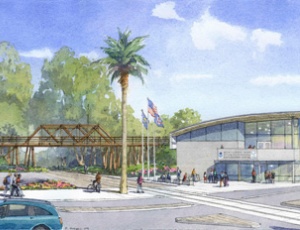The Office of National Marine Sanctuaries, in collaboration with the city of Santa Cruz and the National Marine Sanctuary Foundation, has broken ground on the Monterey Bay National Marine Sanctuary Exploration Center, a $15-million, 12,000-sq-ft public-private partnership.

The city has provided the three-quarter-acre lot at the Fun Spot at Pacific Avenue and Beach Street, ONMS has provided the funding to construct the building and the foundation is conducting a $3 million capital campaign to pay for the exhibits.
The Exploration Center provide state-of-the-art, interactive, interpretive exhibits to an anticipated 200,000 visitors annually and will highlight environmentally sustainable green design and construction methods.
Center officials say the project will go out to bid in the next month with the choice of a general contractor made by August and construction starting mid-September. Completion is scheduled for summer 2012.
The center will be an architecturally distinct, two-story building overlooking the ocean designed to meet LEED silver standards.
The site also provides a perfect venue for interpreting watersheds and human impacts on water quality within the sanctuary.
Roaring Camp Railroad utilizes an active rail line bisecting the site and carries passengers up and down the San Lorenzo Valley watershed. The mouth of the San Lorenzo River and Neary Lagoon are adjacent to the site.
Thomas Hacker Architects Inc. has designed an architecturally distinct building with a gentle roofline, a highly visible interior and second-floor views to the ocean.
For easy access and to preserve open space while minimizing site disturbance, the visitor center will be built on a previously developed site within a quarter mi of bus lines and along existing bike trails. Alternative transportation will be encouraged by providing showers for staff members who commute by bicycle.
During the building process, 95% of construction waste will be recycled, thus diverting it away from the landfill. At least 20% of materials will be manufactured and processed within our region. The design includes using Forest Stewardship Council certified sustainable wood, and materials with recycled content including glass, carpets and insulation. Ample, indirect natural daylight and use of thermally insulated glass that transmits light but limits heat gain will enhance indoor comfort while providing excellent views of the sanctuary.
To improve indoor air quality, the center will select urea formaldehyde-free composite wood products and paints, coatings, adhesives and sealants with the lowest possible levels of Volatile Organic Compounds. The center will reduce its energy consumption by 30% or more in comparison to traditional buildings by using set-back thermostats, occupancy sensors for lighting, and exterior sunshade devices, overhangs and baffles that reduce solar heat gain and glare. Fan-assisted stack towers will provide natural ventilation. These and a light-colored roof will also help optimize energy performance and improve thermal comfort and air quality for occupants.
To hold and filter storm water on site, the center will use bioswales, pervious surfaces and other methods, including using some water to irrigate drought-tolerant, native plants in the landscaping. The center will reduce its water usage even further, while still maintaining the highest standards of cleanliness, by incorporating high-efficiency plumbing fixtures such as dual flush toilets, automatic sensors in lavatories, and low-flow or aerated bathroom fixtures and faucets.
In addition, the Exploration Center will educate visitors about the advantages of sustainable building elements.

Post a comment to this article
Report Abusive Comment